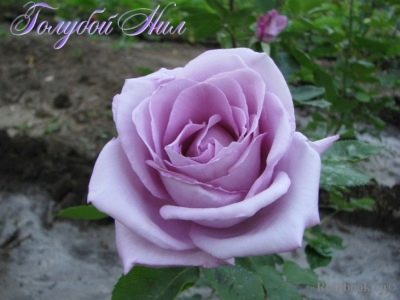
- Authors: G. Delbard
- Name synonyms: Blue Nile
- Breeding year: 1976
- Group: tea-hybrid
- The main color of the flower: lilac
- Flower shape: elegant
- Flower size: large
- Diameter, cm: 11-12
- Flower type by number of petals: thick double
- Scent: a combination of citrus, fruit and tea notes
The rose variety with the romantic name Blue Nile was bred back in 1976 on the basis of the French nursery Georges Delbar. Of course, the main advantage of this variety is the exotic color of its petals.
Description of the variety
Roses of the Blue Nile variety, aka Blue Nile, are hybrid tea flowers intended for cutting and decorative cultivation. The plant forms an erect bush covered with long thorns and dark green glossy leaf blades sitting on long petioles. The plant forms quite compact, growing in height by 100-150 centimeters and increasing in diameter up to 70-100 centimeters. Shoots of the current year are colored light green, and perennials darken over time, gradually becoming brown. The root system of the bush is powerful and rather deep.
Quite large, densely doubled flowers reach a diameter of 11-12 centimeters. They have an elegant shape and grow either singly or in 2-3 buds. The color of 45-60 petals, despite the name, is not blue, but pale lilac. The unusual color persists throughout the flowering period. The scent of the Blue Nile rose is quite bright. It is dominated by fruity notes, but citrus is also felt.
Advantages and disadvantages
The Blue Nile rose variety is quite hardy. Its stems and root system remain unchanged when the temperature drops down to -24 degrees. As a hybrid, the crop has a fairly strong immunity that provides protection against diseases and pests. The plant is not afraid of temperature jumps and a temporary lack of watering. There are no particular drawbacks in this variety, except that the presence of thorns can be mentioned.
Flowering features
Blooming in Blue Nile roses is repeated and prolonged, lasting from June to November. The whole process usually takes place in three waves. The first buds open in June on perennial stems. This is followed by a dormant period, and after a while a second wave starts on the shoots of the current season. For the third time, the flowers open in mid-autumn, shortly before the arrival of frost.
Landing
The Blue Nile rose can be planted from March to October. In the south, the event is organized in the spring, in March-April and at the end of October, and in temperate climates, work begins no earlier than May. For the culture, it is necessary to choose a well-lit place, but not forgetting that the plant cannot be under the scorching sun all day, and around noon it will need shading from the south side. It is also important that the flowers are not exposed to drafts, and the site has protection from the north wind. Soil Blue Nile needs fertile, light and breathable.
It is also necessary that a drainage layer is present on the site. Sandy-clay soil with an acidity of 5.6-6.5 pH is considered optimal for roses. Heavy sandy and acidic soils, as well as those characterized by waterlogging and close occurrence of groundwater, are categorically unsuitable for planting seedlings.Before direct planting, the soil is dug to a depth of 40 centimeters, and is also fed with compost, potassium sulfate, superphosphate and complex mineral fertilizers such as Agricola. The dimensions of the hole are determined in such a way that the grafting site deepens by 3-5 centimeters, and the roots are evenly distributed. The hole is filled with a mixture of sand, fertilizers and soil, which is immediately irrigated with high quality.
A seedling of a rose of the Blue Nile variety is selected necessarily healthy, with a strong stem, a well-developed root system and the absence of blossoming buds. Before planting, its roots are trimmed and immersed in water for a couple of hours to be saturated with moisture. After the seedling is immersed in the hole, the voids are covered with earth, and the surface is compacted. It is also recommended to organize a small earthen filling in a circle, which will improve the flow of moisture to the roots.
Growing and care
Watering Blue Nile roses is not recommended too often, but it is plentiful. In principle, it is better to focus on the condition of the earth in order to prevent it from drying out, but for beginners, you can adhere to the rule of watering once a week, using 5 liters for each bush. The water should be settled and warmed up in the sun. It should be poured in a thin stream, making sure that drops do not fall on the leaf blades and buds. In hot summers, the frequency of irrigation increases, and at the end of flowering, it generally stops.
Of fertilizers, plants respond best to dry mineral mixtures mixed with soil, as well as manure and humus. Top dressing should be applied in the spring, as well as during bud ovary. While the roses are blooming, it is not recommended to fertilize them, but the introduction of potassium-phosphorus mixtures will be useful before preparing for winter. Pruning of rose bushes is organized three times per season. In the spring, the stems that have frozen or broken during the winter are removed, and in the summer, wilted flowers are removed. It is also worth mentioning that in cold climates it is customary to cut the bush to 75 centimeters.
In autumn, damaged and too long branches are removed. As a preparation for winter, the Blue Nile rose should be covered with a thick layer of dry foliage and spruce branches after pruning. In especially cold months, a frame is mounted above the bush, covered with plastic wrap.































































